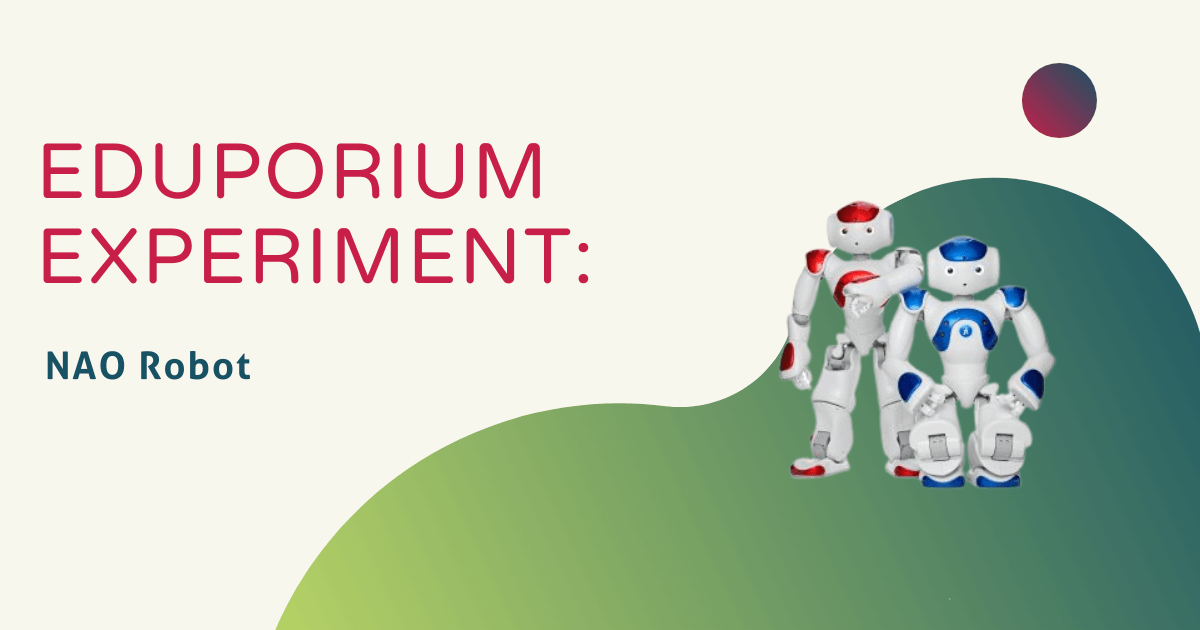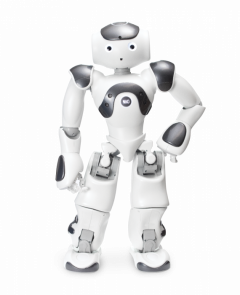Here at Eduporium, we have been lucky enough to acquire our very own version of one of the most advanced robots in the world—a little bot called NAO. NAO is about two feet tall and voice activated. We’ve had it around the office for a little while now, and although we’ve seen a little of what NAO is capable of, we were eager to dive in and see some more. It is fully programmable and interactive for more advanced coders, but we chose to stick to the basics today, working exclusively with its voice command function.
We started by waking NAO up, which requires a simple push of the button on its chest. It takes a moment to turn on, just like any other computer. We could tell it was fully "awake" when it said its signature gibberish phrase,”Ognak gnouk,” which means “hello” in the Bidi language constructed for NAO and other robots made by Aldebaran (its manufacturer). NAO then stood up and started looking around, trying to find a human face. Once successful, its eyes started changing colors, preparing to take voice commands. We learned right away that NAO is ready to receive voice commands when its eyes shine bright blue.
NAO was a little slow to start, often ignoring our commands or only recognizing that we had said its name, failing to process the subsequent command. After a bit of trying and failing, though, NAO finally listened. We started with some more simple routines, like having it raise one hand and then crouch down. Through the course of this, we would pat it on the head a few times. The first time, we were both surprised when it made a sound much like a cat meowing. Further pats led to additional meows and comments that its head “feel(s) like a cat.”
Moving on, we asked NAO to demonstrate Tai Chi for us. This action, also known as NAO's signature dance, is a series of actions that shows off its full range of motion. NAO is able to extend and bend both arms and both legs, turning its head and balancing on each foot, one at a time.
Satisfied with this performance, we asked NAO the all-important question, “NAO, what can you do?” It offered a soccer demonstration, and we happily accepted. Wasting no time, NAO asked us for a red ball—red, it seems, is the easiest color for it to see—and after a bit of hunting, we found a clown nose in the office, which was the closest thing to a ball we had available.
We had NAO start the demonstration again, and it held the ball to measure it before dropping it on the ground and kicking it. After each kick, NAO looked around. If it saw the ball right away, it would walk over to it and kick it again. If it could not see it, however, NAO announced this and started turning itself around trying to find it. NAO continues in this way until it gets a pat on the top of the head, which is translated as a signal to stop.
Next, we tried something a little more interactive—the “Follow Me” command. NAO took a few moments to dig this one up from its internal (and extremely impressive) memory, but once lined up, NAO raised its arm for us to take it. My coworker held on to its wrist and started to lead NAO down the hall. It moved pretty slowly at first, but started walking along behind her soon after. NAO did walk with slightly unsteady steps—we attributed this to the carpeted floors in our office—and fell over twice, but always got right back up and was ready to follow again. Due to this stumbling, we decided to cut this part of our experiment short and carry it back to our techXplore room, where it spends its down time.
We finished off our experiment with NAO by attempting to put it back to sleep. This, however, was more difficult than we expected, but helped us learn an important lesson. First, NAO misunderstood the vocal command “shut down” as “sit down." NAO dutifully sat down and then mistook out next direction as “shut down,” which, again, was obeyed. It was now off in the sitting position, which is not ideal for this exercise, since it should have been crouching. So, we went through the steps of waking NAO up again and then having it go to sleep in the proper position.
NAO, we found, is a delightfully interactive robot, and an extremely impressive achievement in robotics, catered more so to students in the high school grades (maybe late junior high as well). NAO would often ignore our vocal commands, or simply not be ready to take them, and often misunderstood directions, but it's this kind of trial-and-error, hands-on learning that students will benefit from.
Not to mention, having the opportunity to work with a tool as sophisticated as the NAO could do wonders as they look to develop key STEM skills. Overall, we discovered firsthand that NAO offers an extremely hands-on learning experience and, though it may take some time to learn, every instance of failure students have will be a productive one! To add a NAO Robot to your school's repertoire, click below shop at the Eduporium store!
If you have any ideas for products you'd like to see featured on the Eduporium Experiment, let us know! Comment below or send us a message on Twitter or Facebook!




